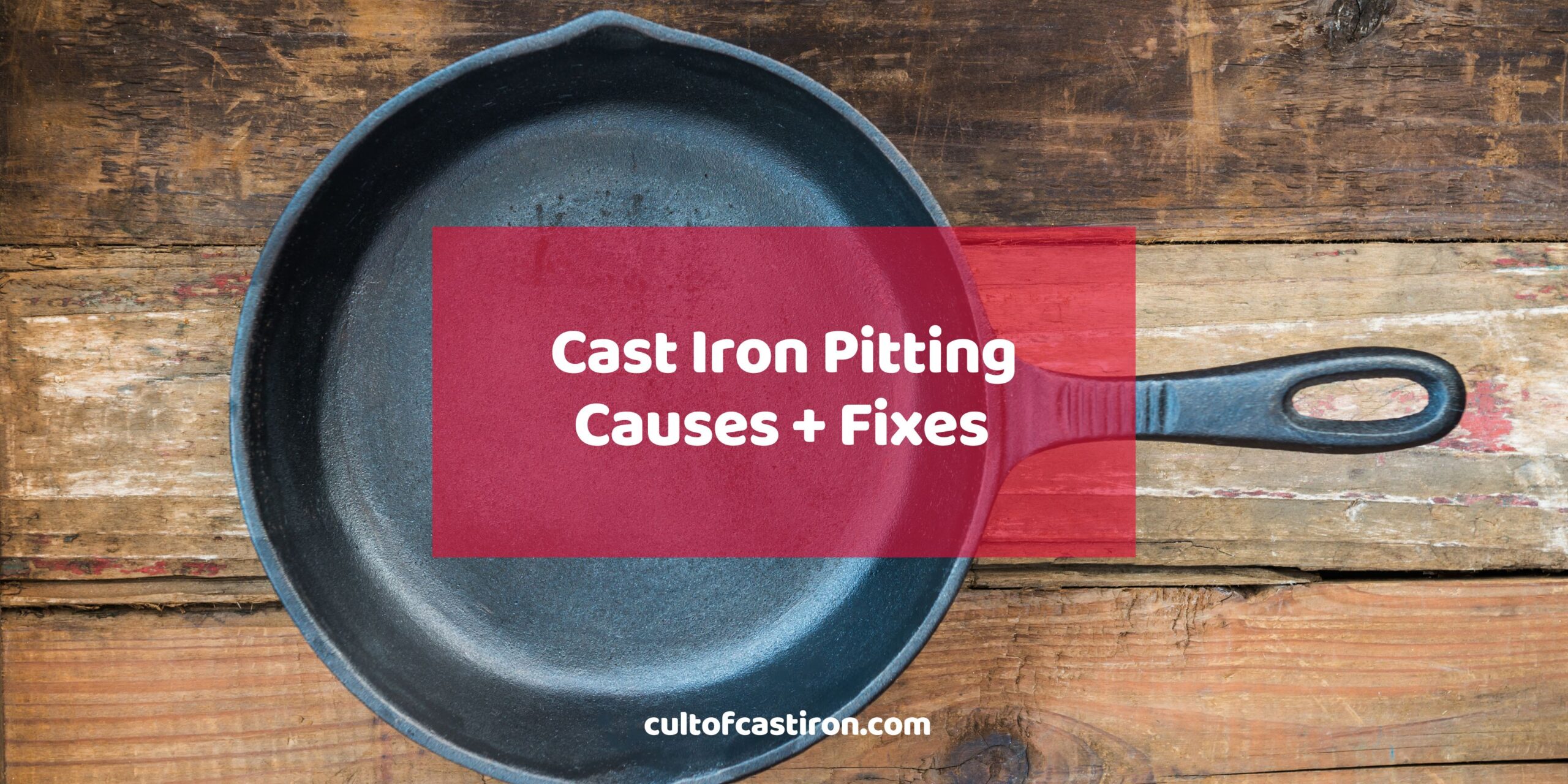Cast iron cookware are incredibly durable given that they are properly seasoned and maintained. However, even with its exceptional level of resilience, cast iron may develop pock-marks on its surface called pitting if not properly looked after.
This form of wear can seem alarming. But fear not—pitting is a solvable issue. In this article, we’ll delve into the causes of cast iron pitting, how to identify it, and most importantly, detailed solutions to restore your cookware’s pristine condition. Whether you’re a seasoned cast iron veteran or a curious newcomer, understanding pitting is essential for maintaining the longevity of your cookware.
Keep reading as we take a more in-depth look at why your cast iron pan developed pitting, and how you can prevent it from happening in the future.
What Does Pitting on Cast Iron Look Like?
Pitting on cast iron appear as small, crater-like indentations on the surface that can feel rough to the touch, contrasting with the typically smooth or evenly seasoned patina of well-maintained cast iron. These depressions may appear darker or rust-colored, signaling potential corrosion beneath the seasoning layer.
Beyond just a visual blemish, pitting affects the non-stick properties and heat distribution of your cookware. Also, it can affect the searing performance of your skillet, as these pits will cause uneven contact between the surface and whatever it is that is being cooked on the skillet. In severe cases, pitting can become so advanced that it weakens the structural integrity of the cookware, leading to cracks or warping, which can ruin the cast iron and render it unusable.
What Causes Pitting on Cast Iron?
Pitting on cast iron can be caused by physical and chemical reactions. Here’s a deeper look into these causes:
Untreated rusting
While surface rusting is a common problem that is encountered even by seasoned cast iron owners, leaving the skillet to rust for a long time can create small pits on the surface as the rust eats away at the iron. This process is gradual and can be accelerated in certain conditions, like high humidity or when corrosive substances like salt are present.
As the metal continues to corrode, these pits can become deeper and larger, eventually becoming difficult or impossible to repair. The pitting not only damages the cookware but also provides more surface area where rust can form and moisture can collect, exacerbating the problem.
Cooking with acidic food
It’s no secret that acids can eat away exposed cast iron surfaces. In fact, a study shows that cooking acidic food on a cast iron skillet can leach iron particles into your meals. While this can be beneficial for your health, the leaching also means that the metal is being worn away, creating tiny pits where the iron has dissolved.
With that said, I’ll still argue that cooking acidic foods on cast iron is not a bad thing in itself – it’s about how you clean and maintain the skillet afterwards that matters more. If you do not wash out acidic ingredients like tomatoes or vinegar, they can wear down the seasoning layer over time, exposing the iron to moisture, and thus, rusting.
Using metal utensils
Cooking with metal utensils on cast iron can potentially lead to pitting, but the process is not as straightforward as with rust or acidic food damage.
Cast iron and its seasoning are more resilient than you may think, and using metal utensils while cooking won’t damage the skillet too much. However, these metal utensils can cause small abrasions that can cause damage on the cast iron’s seasoning. Once the seasoning is compromised, the bare iron is exposed to air and moisture, which can lead to rust formation. If these scratches are minor and the cookware is properly cared for afterward, pitting may not occur. However, repeated scratching over the same area can worsen the damage.
Buying low quality cast iron products
Low-quality cast iron products from questionable brands can be more susceptible to pitting, and there are several reasons for this.
Lower quality cast iron may have impurities such as scrap metals mixed into the iron during the casting process. These impurities can react differently to the rigors of the kitchen, creating weak points that are more prone to rusting, and even denting.
The quality of the production process is also a factor here, as flaws in the casting may result in pits and other imperfections being built into the product.
investing in high-quality cast iron cookware is an investment in longevity. The craftsmanship that goes into producing a high-quality skillet ensures that with proper care, it can last for generations without significant pitting issues. If opting for less expensive options, extra diligence in maintenance—such as regular seasoning, careful cleaning, and thorough drying—is required to mitigate the risks of pitting.
How to Fix Pitted Cast Iron
Fixing pitted cast iron requires a multifaceted approach depending on the severity of the pitting. Here are some methods with step-by-step instructions:
Approach 1: Just use it
A pitted cast iron is still useable if it is shallow enough. In fact, I am of the opinion that the best way to fix pitted cast iron is by using it regularly. Since the seasoning of the cast iron improves as you use it, regular usage can fill in these pits and soften the height difference between the pit and the rest of the surface. While the surface won’t be perfectly smooth, it useable nonetheless.
Approach 2: Re-seasoning
If you do not want to sit and wait for the pits to gradually improve on their own, then you should apply a layer seasoning or two (or even three) to bring the surface up to snuff. Since the whole seasoning process is a different kind of beast, I’d direct you to read the comprehensive cast iron seasoning guide that I’ve published here.
Approach 3: Sanding down the pits
If you really want to remove the pits on your cast iron skillet, then you’ll have to sand it smooth until you’ve restored the uniform level on its surface.
However, this comes with its own can of worms. While sanding a cast iron skillet is not technically bad in itself, doing it too much can make your skillet thin and structurally weak. Moreover, making your skillet too smooth can make it difficult for the seasoning to adhere to the surface. If you want to learn more about how to smooth a cast iron skillet, then read our quick guide here!
There’s no need to spiral down the pits of despair
Understanding and addressing the issue of pitting in cast iron cookware is crucial for anyone who values the longevity and performance of these kitchen staples. Pitting, if left unchecked, not only compromises the cookware’s functionality but also its cherished role in our culinary adventures. However, with the right knowledge and care, even pitted cast iron can often be restored to its former glory.
If you want to learn more about cast iron cookware, apart from how to store cast iron cookware, go ahead and explore Cult of Cast Iron for more guides and blog articles! Cult of Cast Iron is your ultimate source of information and inspiration for anything and everything cast iron cookware.
Join the Cult of Cast Iron today and discover the wonders of cast iron cookware!

Miguel is a cast iron enthusiast from Cavite, Philippines. He works in the digital marketing field as a content marketing strategist. On the side, he manages a small online bookstore and tends to his plants.

